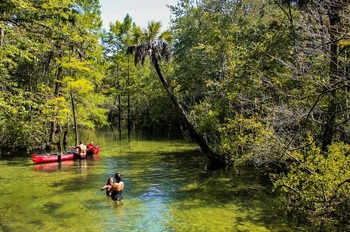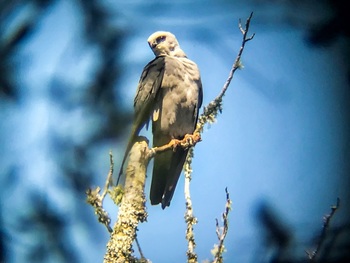 Sylvan Spring by Whitney Gray
Our staff recently spent a couple of hours visiting one of our Panhandle Section sites, Pitt and Sylvan Springs Recreation Area. Located 90 minutes west of Tallahassee in Bay County, this beautiful Northwest Water Management District property is a must-visit for those who appreciate the "Real Florida!" Several miles of shaded trails provide access to three lovely freshwater springs and acres of floodplain/slope forest, home to a plethora of birds, dragonflies and colorful wildflowers. There were great looks at a Louisiana waterthrush and a very photogenic five-lined skink! If you're driving along state road 20 between Panama City and Tallahassee, plan on stopping at Pitt and Sylvan Springs for an hour or two. Take a hike, have a picnic and don't forget your swim gear...the cold crystal clear spring water is very inviting on a hot sunny day!
 Mississippi kite by Andy Wraithmell
It won't be long before this small smoky gray raptor leaves Florida and heads south for the winter. A common summer resident in North Florida and the Panhandle, the Mississippi Kite is a delight to see, flying effortlessly above the treetops searching for a dragonfly or other airborne buggy meal! For guaranteed looks of this raptor, head to Tallahassee's urban parks. J R Alford Greenway, Alfred B. Maclay Gardens State Park and Elinor Klapp-Phipps Park all provide refuge for this species between April and September. During migration you may well encounter one or more kites anywhere in the state. A great place to enjoy them and other migratory raptors is the Florida Keys Hawkwatch at Curry Hammock State Park. If you are planning to visit this famous hawkwatch this fall you may want to go during the Birding Festival of the Keys in late September. This superb event will give you the opportunity to see Mississippi Kites plus a whole bunch of other migratory birds.
 wild turkeys by FWC
Join Andy Wraithmell and Whitney Gray on Saturday September 9th for a Wings Over Florida field trip at Joe Budd Wildlife Management Area in Gadsden County. This beautiful property is home to over 150 species of birds. Find out more about this field trip on our events webpage.
 Northern cardinal by Andy Wraithmell
Have you noticed that your cardinals look a bit worse for wear at this time of year? What’s up with that? Well, bird feathers are not that different to our nails and hair, and as a result they are subject to wear and tear, and are easily damaged. Feathers are ‘dead’ structures and cannot heal themselves, so birds shed or drop them and grow new ones. This process is called molting and all birds go through it. Cardinals, and other songbirds in our area typically go through this process once a year in late summer, which is why they’re looking a bit scruffy right now. Don’t worry though, they’ll be looking sharp again in a few weeks.
|